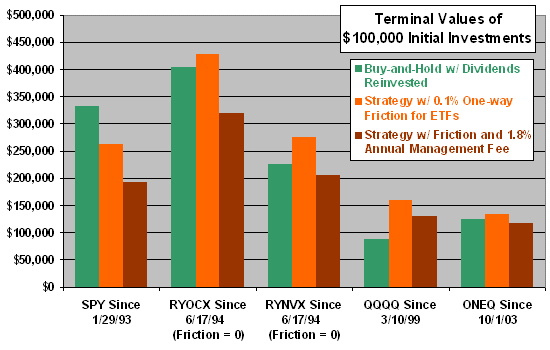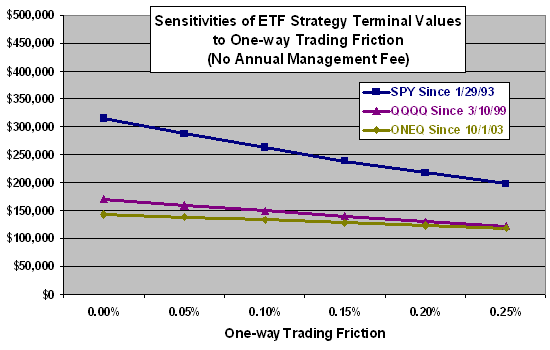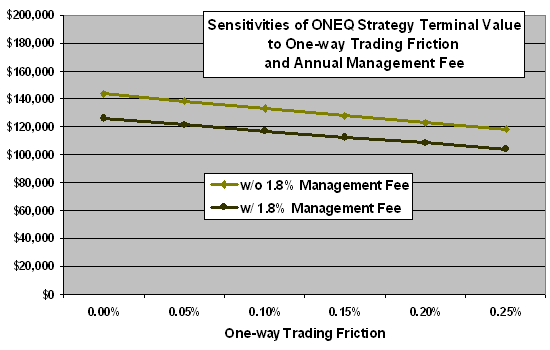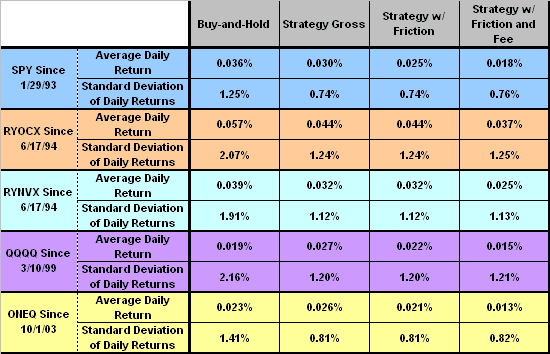A reader asked whether Lussenheide Capital Management’s momentum timing mechanism (100-day NASDAQ Composite Index moving average crossings, with proprietary filter) beats buy and hold over the long run, noting that the company’s web site presents at “Trend Following Performance” an independently validated annualized return of over 16% for “a very simple trend following system.” The discussion of performance states: “The systems used here at…Lussenheide Capital Management Inc., uses [sic] this basic system, along with a mechanical, proprietary trading filter. Although our returns are comparable or better with those shown below, our system has more desirable characteristics, including fewer trades and less whipsaws amongst others.” The notes at the bottom of the performance table state that results exclude “fund expenses” and “advisory management fees.” Without the specifications for the proprietary filter, we can test only basic concepts directly. Using daily closes of the NASDAQ Composite Index and daily dividend-adjusted closes for various potential trading vehicles through 2/12/10, we find that:
Based on data since fund inception, we test the performance of a 100-day simple moving average (SMA) trading signal for the following diversified exchange-traded funds (ETF) and mutual funds:
- S&P Depository Receipts (SPY) since 1/29/93.
- Rydex NASDAQ-100 (RYOCX) since 6/17/94.
- Rydex Nova (RYNVX) since 6/17/94.
- PowerShares QQQ (QQQQ) since 3/10/99.
- Fidelity NASDAQ Composite Index Tracking (ONEQ) since 10/1/03
Sample periods therefore range from about 6.5 years 16 years, small compared to a 100-day SMA.
Trading assumptions are as follows:
- When the NASDAQ Composite Index crosses above (below) its 100 trading-day SMA, buy (sell) a specified fund. Trades occur at the close coincident with signal generation (we slightly anticipate the signal).
- Return on cash is the contemporaneous short-term Interest Rate Composite.
- Trading frictions (transaction fee plus bid-ask spread) for ETFs are a small percentage of portfolio value (a range of 0.00% to 0.25%). Trading frictions for the Rydex funds are zero (or rather, impounded in fund performance).
- There is an annual management fee of 1.8%, deducted the last trading day of each calendar year.
- Ignore tax implications of trading.
The following chart shows the terminal values of $100,000 initial investments in each of the five trading funds/timeframes for: (1) a buy-and-hold strategy; (2) the 100-day SMA crossing strategy with with 0.1% one-way trading friction for the ETFs; and, (3) the 100-day SMA crossing strategy with with 0.1% one-way trading friction for the ETFs and 1.8% annual management fee for all funds. Results show that:
- With trading friction but no management fee, the 100-day SMA crossing strategy beats buy-and-hold in four of five cases.
- With trading friction and management fee, the 100-day SMA crossing strategy beats buy-and-hold in one of five cases.
- The timeframe of analysis may be decisive, with performance of the timing strategy materially dependent on broad market trend and volatility during the test period (see the blog entry of 2/8/10).
How sensitive are results to the assumed level of trading friction?

The next chart shows the terminal values of $100,000 initial investments in each of the three ETFs/timeframes for one-way trading frictions ranging from 0.00% to 0.25%. The cumulative effect of trading friction over long periods can be substantial, and sometimes decisive with respect to outperforming a buy-and-hold benchmark. Actual trading frictions depend on specific broker transaction fees, trading vehicle bid-ask spread and portfolio size. Achieving low trading friction is especially problematic for small portfolios.
How big is the effect of a management fee?

The final chart shows the terminal values of $100,000 initial investments in ONEQ since 10/1/03 for one-way trading frictions ranging from 0.00% to 0.25%, with and without the annual management fee. The cumulative effect of the management fee is substantial.

For reference, the following table lists the daily average (arithmetic mean) returns and standard deviations of daily returns for the five funds/timeframes. The “Buy-and-Hold” column involves no trading. The “Strategy Gross” column incorporates market timing based on 100-day SMA crossings as described above. The “Strategy w/ Friction” column debits “Strategy Gross” with 0.1% one-way trading friction (except for the Rydex funds). The “Strategy w/ Friction and Fee” column debits “Strategy w/ Friction” with a 1.8% management fee charged the last trading day of each calendar year. In general, the 100-day SMA trading strategy reduces average daily return, but also reduces daily return volatility.

Note that evidence from simple tests:
- Does not reliably point to any “best” SMA calculation interval for generating crossing signals to exploit long-term stock market trends over the time frames tested above.
- Does not show that buffering SMA crossing signals to reduce trading enhances performance.
The Disclosure for Lussenheide Capital Management’s web site states:
- “No representation is being made that the information will produce trading profits.”
- “In no event shall Bill Lussenheide or his family be held liable for any special, incidental, or consequential damages, whatsoever (including: without limitation, trading losses or any other losses incurred) arising from the use or inability to use the information contained in his publications…”
In summary, evidence from simple tests on limited samples supports a belief that a strategy employing long-term simple moving average crossing signals to enter and exit equities may outperform a buy-and-hold strategy, depending on market conditions and the level of trading frictions/fees.